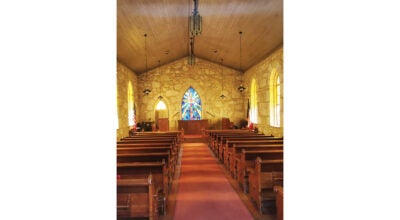New club celebrates old engine collecting
Published 5:00 am Monday, May 19, 2008
The high price of gasoline is not enough to deter a pair ofLincoln County men from collecting, restoring and displayingantique internal combustion engines, especially when one considersthose engines only fire once every few seconds.
Steven Brumfield and Bobby McGowen gladly feed fuel into theircollection of hit-and-miss engines – one-cylinder, cast iron motorsthat date back a century to the first days of internal combustion -so the public may see them in action.
What was once a personal hobby between Brumfield and McGowen isnow Brookhaven’s newest club – the Old South Engine Club. Eventhough the club is still far from official and withoutdocumentation or registered members, its first show on Saturday atthe Hansel King Sportsplex was a success, with 74 engines ondisplay from 22 exhibitors from Mississippi and Louisiana.
“There’s a lot of us around Brookhaven who have these oldengines,” Brumfield said. “We go to a lot of engine shows indifferent places across Mississippi, so we decided to have one inBrookhaven and see what we could do.”
Brumfield, who has been collecting for almost 10 years, saidhit-and-miss engine collection was popular throughout the country,especially the South, with several clubs across Mississippi,Alabama and Georgia. Dedicated collectors often cross state linesto attend engine shows, Brumfield said, because of the attractionto the engines’ antique value.
“A lot of people collect antiques – that’s probably the reasonwhy a lot of people are getting into it,” he said. “Some peoplecollect antique furniture; we just collect antique engines. Justpreserving history is really what we’re trying to do.”
The small, putt-putt engines carry a great deal of history,representing a time when the modernization of agriculture firstbegan. In many cases, the hit-and-miss engines replaced mules andhorses for everyday jobs around farms, Brumfield said.
By linking an engine’s spinning flywheels to a farm machine witha belt, the engines – most of which average around 4 to 5horsepower – could perform a variety of tasks that once requiredgreat labor.
In the early 1900s, the engines were used to run a variety ofmills, water pumps and air compressors. They were also used todrive electric motors and generate power; were developed to powermilking machines on dairy farms and were even installed on thefirst lawn mowers and washing machines.
“Back then, when a man went to town and bought his wife agas-powered washing machine, that was the equivalent of going outand getting the biggest, best Maytag you can get today,” Brumfieldsaid. “You could use these engines to run anything back then thatyou would use an electric motor for today.”
Brumfield said memories of the engines performing old, simpletasks such as these are usually what draws passers-by into thetrade.
“At these shows, a lot of people will come by and say, ‘Iremember when my grandpa had one of those,'” he said. “People,especially older folks, remember these engines from back when timeswere tough. You don’t realize how easy you have it now – you justflip a switch and you’ve got water and power. Back then, you had toget out there and get those engines going if you wanted to pumpwater or generate power.”
Brumfield said a lot of the hit-and-miss engines can be found inlong-forgotten places – lying around old houses, barns and pastures- still set up on the site where they were last used more than 50years ago. Most of the sites, he said, were the homeplaces of thewealthy who could afford to maintain what was then cutting-edgetechnology through the Great Depression.
“A lot of elderly people have them on their property, justsitting there in the same spot they were when they were shut down,”he said. “A lot of the ones we found and restored were found justby talking to folks. They’ll say, ‘Yeah, we’ve got one, it’s growedup in the bushes – get a saw and cut it out.'”
Of course, Brumfield said, the engines are often found in statesof disrepair. The process of restoring the engines and seeing themputt-putt again after decades of neglect is the rewarding feelingthat keeps engine collectors collection, Brumfield said.
And, in an ironic crossing of worlds, Brumfield said there isone place engine collectors can go to find almost every part, screwand washer needed to bring the engines back to life: eBay.
“You would not believe – probably 80 percent of the parts youneed you can get off eBay,” he said. “People buy and sell parts andeven complete engines.”
Some parts, however, cannot be found on the Internet and must becrafted. McGowen, who has chased after the old engines for morethan 30 years, makes his own parts in his shop.
“We try to make them back just like they were built – as nearoriginal as we can,” he said. “Anyone can change it up and makethem run forever.”
McGowen said crafting one’s own parts instead of simply orderingthem and installing them makes the connection with the engines’history that much stronger. Many – if not most – of the oldhit-and-miss engines were hand-crafted.
“People didn’t have the equipment to make things back then -they just had a hammer and chisel and thought they’d make anengine,” McGowen said. “Almost every blacksmith shop back at theturn of the century would make an engine for you.”
McGowen makes parts for his collection of engines, several ofwhich have exceeded 100 years of age. He has a water pump enginebuilt in 1906 that still runs every day. McGowen also has an enginefrom the Fraign family of Brookhaven that once powered one of thefirst running water systems in Lincoln County, he said.
And McGowen is always on the lookout for more engines to add tohis collection. He loves the craftsmanship.
“If you ever had one and brought it back to life, you’dunderstand,” he said.





